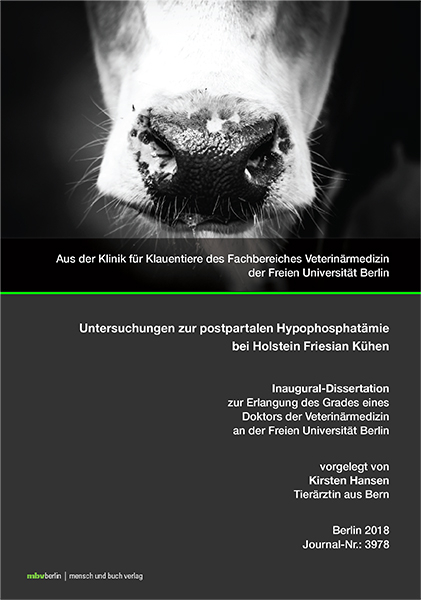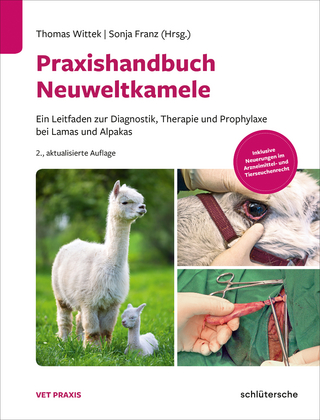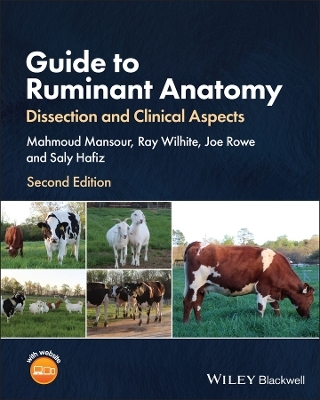
Untersuchungen zur postpartalen Hypophosphatämie bei Holstein Friesian Kühen
Seiten
2018
|
1. Aufl.
Mensch & Buch (Verlag)
978-3-86387-881-8 (ISBN)
Mensch & Buch (Verlag)
978-3-86387-881-8 (ISBN)
- Keine Verlagsinformationen verfügbar
- Artikel merken
Investigation of post partal hypophosphatemia in Holstein Frisian cows
As well in the current veterinary practice as in the literature from the 1970th and 1980th there is still the opinion, that dairy cows can get recumbent because of hypophosphatemia and that a post partal hypophosphatemia has a negative influence on incidence of puerparale diseases and the milk yield or the reproductive performance. Different kinds of treatment are in practical use for hypophosphatemia therapy.
In this retrospective study calcium-, βHB- and the NEFA-concentration from day 0, 1, 3 and 5 p.p., the lactation number, the length of the dry period, the back-fat thickness at calving and the calving process from 2094 cows and heifers of one dairy farm were evaluated in addition to the phosphate concentration. For statistical reasons the correlation proportion, the ANOVA-Analyze, linear regression with or without repeated measures and logistic regression were used. To take a weighting of the evaluated factors and their influence on the phosphate concentration there were used multiple regression-models. The correlation and regression models were used to evaluate the influence of the phosphate concentration in serum on milk yield and reproductive performance as well as the incidence of milk fever, recumbency of other reasons, ketosis, retained placenta, endometritis, displacement of abomasum or mastitis.
The mean serum phosphate concentration was 1,03 mmol/l at the day of calving and increased rapidly to 1,69 mmol/l at day 5 p.p. on average. About 75% of the cows had a phosphate concentration below 1,25 mmol/l, even 6% had a severe hypophosphatemia with concentrations below 0,5 mmol/l. The investigation of factors from ante and postpartum factors revealed that there is a significant influence of the lactation number, the total dry period length, back fat thickness and the concentration of calcium, βHB and NEFA. The most important influence was shown for the lactation number, as well as the concentration of calcium and NEFA. That infers that there is a high influence of the age, the capacity of mobilization as well as the feed intake on the postpartum phosphate concentration.
The postpartum serum phosphate concentration has a significant influence on the milk yield in the first 100 days after calving, but the declared variability is, with 3,2% at maximum, very low. The phosphate concentration has a similar influence on the reproductive performance as the number of inseminations, days until first service and days open. Although there are significant relationships the influence on the performance (milk and production yield) is low. The declared variability is low. In consideration of lactation number the influence decreased or disappeared totally.
The influence of the phosphate concentration on the risk of a puerperal disease is minor. The phosphate concentration is affected significantly by the occurrence of milk fever in its height as well as in its development. The influence of the phosphate concentration on the milk fever risk is in parts significant but minor. Comparable relations exist between the phosphate concentration and the other reported puerperal diseases. Sometimes there were significant relationships, but in the regression models the declared variability was very low. The significant, but minor influence of the phosphate concentration on the risk of disease is explained by reduced feed intake and reduced loss of phosphate by milk delivery caused by the disease itself.
The apparent relationship between the phosphate concentration and the risk of disease may be due to the relation affected by the reduced loss of phosphate by milk delivery caused by illness and reduced feed intake.
It was illustrated, that the phosphate concentration of first days after calving is a copy of the age, the feed intake and the loss by milk delivery. Several apparent relations to the performance parameters can be explained by this fact. Therefore there exists a negligible minor relation between the occurrence of a puerperal disease and the phosphate concentration. The same applies to the relation between the phosphate concentration and the milk yield or reproductive performance. The hypophosphatemia p.p. is a physiological phenomenon increasing with age, which is explained by age-related reduced mobilization capacity of phosphate, the reduced feed intake ante partum and the onset of milk production.
A therapy of the hypophosphatemia is unnecessary. The attention should be on the causing factor as the motility of the rumen, the feed intake or the hypocalcemia. Untersuchungen zur postpartalen Hypophosphatämie bei Holstein Friesian Kühen
Sowohl in der kurativen Praxis als auch in der Literatur der 1970er und 1980er Jahre wird immer noch die Meinung vertreten, dass Milchkühe aufgrund einer Hypophosphatämie zum Festliegen kommen und eine postpartale Hypophosphatämie einen negativen Einfluss auf die Erkrankungswahrscheinlichkeit und die Milch- und Reproduktionsleistung hat. Verschiedene Formen der Behandlung werden in der Praxis zur Therapie einer Hypophosphatämie angewendet.
In einer retrospektiven Beobachtungsstudie wurden neben der Phosphatkonzentration die Calcium-, βHB- sowie NEFA-Konzentrationen der Tage 0, 1, 3 und 5 p.p., die Laktationszahl, die Trockenstehdauer, die Rückenfettdicke bei der Kalbung und der Kalbeverlauf von 2094 Kalbinnen eines Milchviehbetriebes ausgewertet. Als statistische Testverfahren wurden neben der Berechnung der Korrelationsverhältnisse die ANOVA-Analyse, lineare Modelle mit Messwertwiederholung und Regressionsmodelle verwendet. Um eine Gewichtung der untersuchten Faktoren auf die Phosphatkonzentration vornehmen zu können, wurden multivariable Regressionsmodelle angefertigt. Der Einfluss der postpartalen Phosphatkonzentration auf die Milch- und Reproduktionsleistung sowie die Erkrankungshäufigkeit von Gebärparese, Festliegen anderer Genese, Ketose, Nachgeburtsverhalten, Endometritis, Labmagenverlagerung und Mastitis wurde mittels Korrelationsberechnung und Regressionsmodellen geprüft.
Der mittlere Serumphosphatgehalt lag am Tag der Kalbung bei 1,03 mmol/l und stieg schnell bis auf durchschnittlich 1,69 mmol/l am Tag 5 p.p. an. Rund 75% der Kalbinnen wiesen am Tag der Kalbung eine Phosphatkonzentration von unter 1,25 mmol/l auf, rund 6% sogar eine starke Hypophosphatämie mit Konzentrationen von unter 0,5 mmol/l. Die Untersuchung von prä- oder peripartalen Faktoren ergab einen signifikanten Einfluss der Laktationszahl, der gesamten Trockenstehdauer, der Rückenfettdicke bei der Kalbung und der Konzentrationen von Calcium, βHB und NEFA auf die Phosphatkonzentration. Den grössten Einfluss hatten die Laktationszahl sowie die Calcium- und NEFA-Konzentration. Daraus lässt sich auch die grosse Bedeutung des Alters, der Mobilisationskapazität sowie der Futteraufnahme für die postpartalen Phosphatkonzentrationen ableiten.
Die postpartale Phosphatkonzentration hat einen signifikanten, aber mit einer erklärten Variabilität von maximal 3,2% sehr geringen Einfluss auf die Milchmengenleistung der ersten 100 Laktationstage. Auf die Reproduktionsleistung wie Anzahl der Besamungen, Rast- oder Güstzeit hat die Phosphatkonzentration einen vergleichbaren Einfluss. Obwohl signifikante Zusammenhänge bestehen, werden die Leistungsparameter (Milch- und Reproduktionsleistung) nur in sehr geringem Masse beeinflusst. Die erklärte Variabilität ist sehr gering. Unter Berücksichtigung der Laktationszahl wird dieser Einfluss jeweils geringer oder verschwindet gänzlich.
Der Einfluss der Serumphosphatkonzentration auf die Erkrankungswahrscheinlichkeit puerperaler Erkrankungen ist verschwindend gering. Die Phosphatkonzentration wird sowohl in ihrer Höhe, als auch im Verlauf, signifikant durch das Auftreten einer Gebärparese beeinflusst. Der Einfluss der Serumphosphatkonzentration auf das Risiko, an einer Gebärparese zu erkranken, ist teilweise signifikant, aber sehr gering. Vergleichbare Beziehungen bestehen zwischen Phosphatkonzentration und den dokumentierten puerperalen Erkrankungen. Konnten teilweise signifikante Zusammenhänge dargestellt werden, war die aus dem Regressionsmodell erklärbare Variabilität stets äusserst gering. Der signifikante, aber geringe Einfluss der Phosphatkonzentration auf die Erkrankungswahrscheinlichkeit ist durch die, von der Grunderkrankung selbst beeinflusste veränderte Futteraufnahme und durch die Verluste über die Milch zu erklären.
Der scheinbare Zusammenhang zwischen Phosphatkonzentration und Erkrankungsrisiko ist augenscheinlich damit zu begründen, dass die Beziehung durch die krankheitsbedingt verringerten Phosphatverluste über die Milch und die geringere Futteraufnahme beeinflusst wird.
Es wurde dargestellt, dass die Phosphatkonzentration in den ersten Tagen post partum ein Abbild des Alters, der Futteraufnahme sowie der Verluste über die Milch darstellt. Darüber lassen sich verschiedene vermeintliche Zusammenhänge zu Leistungsparametern oder der Erkrankungsinzidenz erklären. Somit besteht zwischen dem Auftreten verschiedener puerperaler Erkrankungen und der Serumphosphatkonzentration eine vernachlässigbar kleine Beziehung. Gleiches gilt auch für den Zusammenhang zwischen der Phosphatkonzentration und der Milch- oder Reproduktionsleistung. Die postpartale Hypophosphatämie stellt ein im Alter zunehmendes physiologisches Phänomen dar, das sich durch eine reduzierte Mobilisationskapazität im Alter, eine ante partum reduzierte Futteraufnahme und das Einsetzen der Milchproduktion erklären lässt.
Eine Therapie der Hypophosphatämie als solche ist somit unnötig. Das Augenmerk sollte auf den verursachenden Faktoren wie der Pansenmotilität, der Futteraufnahme oder der Hypocalcämie liegen.
As well in the current veterinary practice as in the literature from the 1970th and 1980th there is still the opinion, that dairy cows can get recumbent because of hypophosphatemia and that a post partal hypophosphatemia has a negative influence on incidence of puerparale diseases and the milk yield or the reproductive performance. Different kinds of treatment are in practical use for hypophosphatemia therapy.
In this retrospective study calcium-, βHB- and the NEFA-concentration from day 0, 1, 3 and 5 p.p., the lactation number, the length of the dry period, the back-fat thickness at calving and the calving process from 2094 cows and heifers of one dairy farm were evaluated in addition to the phosphate concentration. For statistical reasons the correlation proportion, the ANOVA-Analyze, linear regression with or without repeated measures and logistic regression were used. To take a weighting of the evaluated factors and their influence on the phosphate concentration there were used multiple regression-models. The correlation and regression models were used to evaluate the influence of the phosphate concentration in serum on milk yield and reproductive performance as well as the incidence of milk fever, recumbency of other reasons, ketosis, retained placenta, endometritis, displacement of abomasum or mastitis.
The mean serum phosphate concentration was 1,03 mmol/l at the day of calving and increased rapidly to 1,69 mmol/l at day 5 p.p. on average. About 75% of the cows had a phosphate concentration below 1,25 mmol/l, even 6% had a severe hypophosphatemia with concentrations below 0,5 mmol/l. The investigation of factors from ante and postpartum factors revealed that there is a significant influence of the lactation number, the total dry period length, back fat thickness and the concentration of calcium, βHB and NEFA. The most important influence was shown for the lactation number, as well as the concentration of calcium and NEFA. That infers that there is a high influence of the age, the capacity of mobilization as well as the feed intake on the postpartum phosphate concentration.
The postpartum serum phosphate concentration has a significant influence on the milk yield in the first 100 days after calving, but the declared variability is, with 3,2% at maximum, very low. The phosphate concentration has a similar influence on the reproductive performance as the number of inseminations, days until first service and days open. Although there are significant relationships the influence on the performance (milk and production yield) is low. The declared variability is low. In consideration of lactation number the influence decreased or disappeared totally.
The influence of the phosphate concentration on the risk of a puerperal disease is minor. The phosphate concentration is affected significantly by the occurrence of milk fever in its height as well as in its development. The influence of the phosphate concentration on the milk fever risk is in parts significant but minor. Comparable relations exist between the phosphate concentration and the other reported puerperal diseases. Sometimes there were significant relationships, but in the regression models the declared variability was very low. The significant, but minor influence of the phosphate concentration on the risk of disease is explained by reduced feed intake and reduced loss of phosphate by milk delivery caused by the disease itself.
The apparent relationship between the phosphate concentration and the risk of disease may be due to the relation affected by the reduced loss of phosphate by milk delivery caused by illness and reduced feed intake.
It was illustrated, that the phosphate concentration of first days after calving is a copy of the age, the feed intake and the loss by milk delivery. Several apparent relations to the performance parameters can be explained by this fact. Therefore there exists a negligible minor relation between the occurrence of a puerperal disease and the phosphate concentration. The same applies to the relation between the phosphate concentration and the milk yield or reproductive performance. The hypophosphatemia p.p. is a physiological phenomenon increasing with age, which is explained by age-related reduced mobilization capacity of phosphate, the reduced feed intake ante partum and the onset of milk production.
A therapy of the hypophosphatemia is unnecessary. The attention should be on the causing factor as the motility of the rumen, the feed intake or the hypocalcemia. Untersuchungen zur postpartalen Hypophosphatämie bei Holstein Friesian Kühen
Sowohl in der kurativen Praxis als auch in der Literatur der 1970er und 1980er Jahre wird immer noch die Meinung vertreten, dass Milchkühe aufgrund einer Hypophosphatämie zum Festliegen kommen und eine postpartale Hypophosphatämie einen negativen Einfluss auf die Erkrankungswahrscheinlichkeit und die Milch- und Reproduktionsleistung hat. Verschiedene Formen der Behandlung werden in der Praxis zur Therapie einer Hypophosphatämie angewendet.
In einer retrospektiven Beobachtungsstudie wurden neben der Phosphatkonzentration die Calcium-, βHB- sowie NEFA-Konzentrationen der Tage 0, 1, 3 und 5 p.p., die Laktationszahl, die Trockenstehdauer, die Rückenfettdicke bei der Kalbung und der Kalbeverlauf von 2094 Kalbinnen eines Milchviehbetriebes ausgewertet. Als statistische Testverfahren wurden neben der Berechnung der Korrelationsverhältnisse die ANOVA-Analyse, lineare Modelle mit Messwertwiederholung und Regressionsmodelle verwendet. Um eine Gewichtung der untersuchten Faktoren auf die Phosphatkonzentration vornehmen zu können, wurden multivariable Regressionsmodelle angefertigt. Der Einfluss der postpartalen Phosphatkonzentration auf die Milch- und Reproduktionsleistung sowie die Erkrankungshäufigkeit von Gebärparese, Festliegen anderer Genese, Ketose, Nachgeburtsverhalten, Endometritis, Labmagenverlagerung und Mastitis wurde mittels Korrelationsberechnung und Regressionsmodellen geprüft.
Der mittlere Serumphosphatgehalt lag am Tag der Kalbung bei 1,03 mmol/l und stieg schnell bis auf durchschnittlich 1,69 mmol/l am Tag 5 p.p. an. Rund 75% der Kalbinnen wiesen am Tag der Kalbung eine Phosphatkonzentration von unter 1,25 mmol/l auf, rund 6% sogar eine starke Hypophosphatämie mit Konzentrationen von unter 0,5 mmol/l. Die Untersuchung von prä- oder peripartalen Faktoren ergab einen signifikanten Einfluss der Laktationszahl, der gesamten Trockenstehdauer, der Rückenfettdicke bei der Kalbung und der Konzentrationen von Calcium, βHB und NEFA auf die Phosphatkonzentration. Den grössten Einfluss hatten die Laktationszahl sowie die Calcium- und NEFA-Konzentration. Daraus lässt sich auch die grosse Bedeutung des Alters, der Mobilisationskapazität sowie der Futteraufnahme für die postpartalen Phosphatkonzentrationen ableiten.
Die postpartale Phosphatkonzentration hat einen signifikanten, aber mit einer erklärten Variabilität von maximal 3,2% sehr geringen Einfluss auf die Milchmengenleistung der ersten 100 Laktationstage. Auf die Reproduktionsleistung wie Anzahl der Besamungen, Rast- oder Güstzeit hat die Phosphatkonzentration einen vergleichbaren Einfluss. Obwohl signifikante Zusammenhänge bestehen, werden die Leistungsparameter (Milch- und Reproduktionsleistung) nur in sehr geringem Masse beeinflusst. Die erklärte Variabilität ist sehr gering. Unter Berücksichtigung der Laktationszahl wird dieser Einfluss jeweils geringer oder verschwindet gänzlich.
Der Einfluss der Serumphosphatkonzentration auf die Erkrankungswahrscheinlichkeit puerperaler Erkrankungen ist verschwindend gering. Die Phosphatkonzentration wird sowohl in ihrer Höhe, als auch im Verlauf, signifikant durch das Auftreten einer Gebärparese beeinflusst. Der Einfluss der Serumphosphatkonzentration auf das Risiko, an einer Gebärparese zu erkranken, ist teilweise signifikant, aber sehr gering. Vergleichbare Beziehungen bestehen zwischen Phosphatkonzentration und den dokumentierten puerperalen Erkrankungen. Konnten teilweise signifikante Zusammenhänge dargestellt werden, war die aus dem Regressionsmodell erklärbare Variabilität stets äusserst gering. Der signifikante, aber geringe Einfluss der Phosphatkonzentration auf die Erkrankungswahrscheinlichkeit ist durch die, von der Grunderkrankung selbst beeinflusste veränderte Futteraufnahme und durch die Verluste über die Milch zu erklären.
Der scheinbare Zusammenhang zwischen Phosphatkonzentration und Erkrankungsrisiko ist augenscheinlich damit zu begründen, dass die Beziehung durch die krankheitsbedingt verringerten Phosphatverluste über die Milch und die geringere Futteraufnahme beeinflusst wird.
Es wurde dargestellt, dass die Phosphatkonzentration in den ersten Tagen post partum ein Abbild des Alters, der Futteraufnahme sowie der Verluste über die Milch darstellt. Darüber lassen sich verschiedene vermeintliche Zusammenhänge zu Leistungsparametern oder der Erkrankungsinzidenz erklären. Somit besteht zwischen dem Auftreten verschiedener puerperaler Erkrankungen und der Serumphosphatkonzentration eine vernachlässigbar kleine Beziehung. Gleiches gilt auch für den Zusammenhang zwischen der Phosphatkonzentration und der Milch- oder Reproduktionsleistung. Die postpartale Hypophosphatämie stellt ein im Alter zunehmendes physiologisches Phänomen dar, das sich durch eine reduzierte Mobilisationskapazität im Alter, eine ante partum reduzierte Futteraufnahme und das Einsetzen der Milchproduktion erklären lässt.
Eine Therapie der Hypophosphatämie als solche ist somit unnötig. Das Augenmerk sollte auf den verursachenden Faktoren wie der Pansenmotilität, der Futteraufnahme oder der Hypocalcämie liegen.
| Erscheinungsdatum | 28.09.2018 |
|---|---|
| Verlagsort | Berlin |
| Sprache | deutsch |
| Maße | 148 x 210 mm |
| Themenwelt | Veterinärmedizin ► Großtier |
| Schlagworte | blood sampling • dairy cows • Holstein-Friesian • Hypophosphatemia • post partum |
| ISBN-10 | 3-86387-881-7 / 3863878817 |
| ISBN-13 | 978-3-86387-881-8 / 9783863878818 |
| Zustand | Neuware |
| Informationen gemäß Produktsicherheitsverordnung (GPSR) | |
| Haben Sie eine Frage zum Produkt? |
Mehr entdecken
aus dem Bereich
aus dem Bereich
ein Leitfaden zur Diagnostik, Therapie und Prophylaxe bei Lamas und …
Buch | Hardcover (2023)
Schlütersche (Verlag)
149,00 €
Buch | Softcover (2023)
John Wiley & Sons Inc (Verlag)
185,00 €


